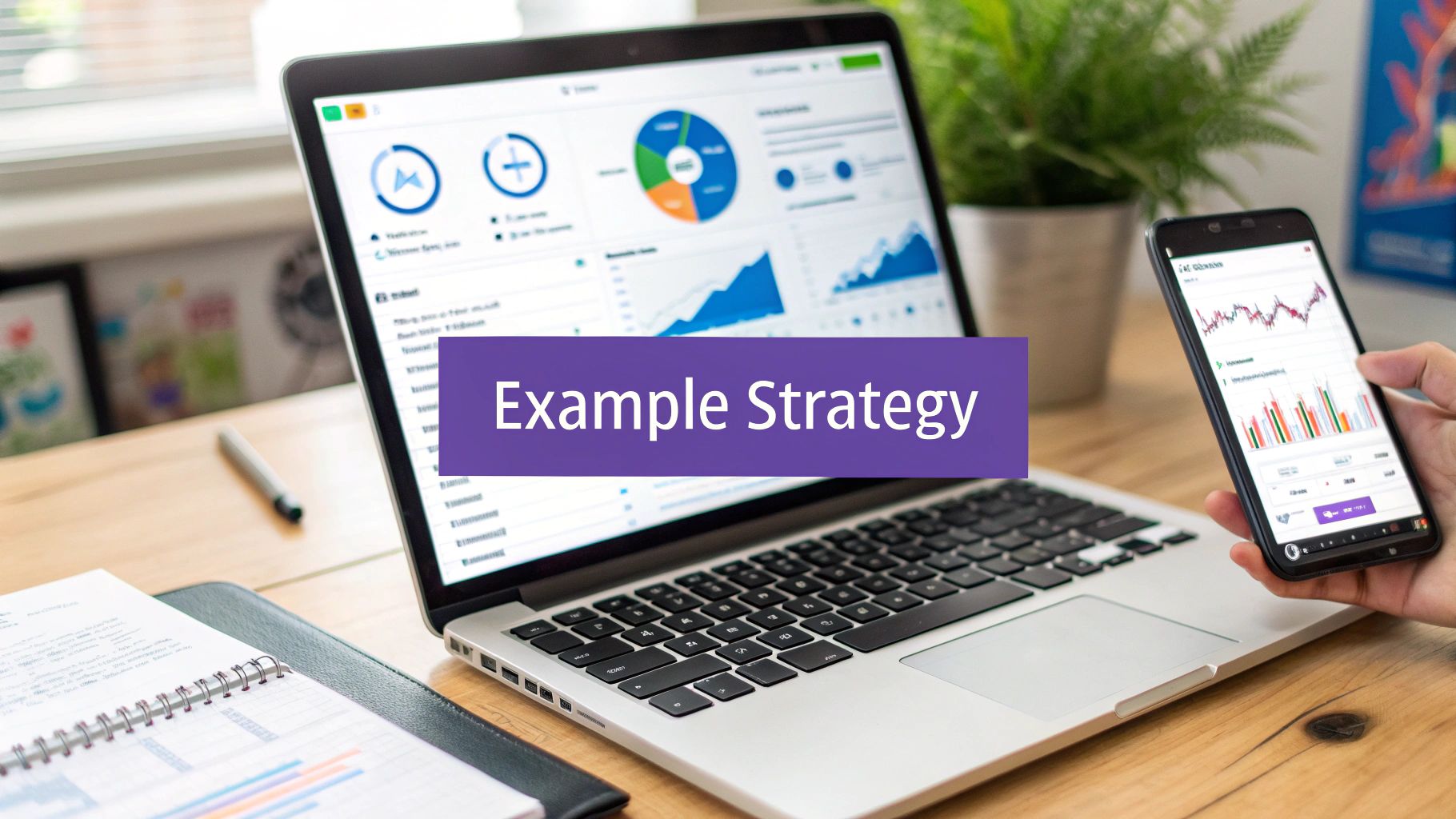Your Ultimate Social Media Audit Checklist: 8 Steps for 2025

In the fast-paced world of social media, a strategy that worked yesterday might be obsolete today. A stagnant approach can lead to wasted resources, missed opportunities, and a brand presence that fails to connect. This is where a methodical social media audit becomes essential. It’s far more than a simple follower count; it’s a comprehensive examination of what’s working, what isn’t, and precisely where you can optimize to achieve your core business objectives.
This guide provides a definitive social media audit checklist, designed to be your roadmap for a complete strategic overhaul. We will navigate you through eight critical areas, offering specific, actionable steps and practical insights. Our goal is to help you transform your social channels from passive digital outposts into dynamic engines for growth and engagement.
By following this checklist, you'll uncover hidden opportunities and gain the clarity needed to refine your strategy for maximum impact. From fine-tuning your profiles and analyzing content health to benchmarking against competitors and proving ROI, this audit covers every facet of a successful social presence. Let’s begin the process of building a smarter, more effective social media plan.
1. Social Media Profile Audit and Optimization
The first step in any robust social media audit checklist is to examine your digital storefronts: your social media profiles. This foundational review ensures consistency, completeness, and brand alignment across all platforms. Think of it as a crucial health check for your brand's first impression, directly impacting how potential followers and customers perceive your business. A cohesive, optimized profile not only looks professional but also improves discoverability and builds immediate trust with your audience.

This audit item is foundational because an incomplete or inconsistent profile can undermine even the most brilliant content strategy. It's the equivalent of having a messy, poorly-lit storefront with a broken sign; it deters people before they even step inside. For professionals looking to streamline this process, platforms like MakerBox can generate optimized bios and profile images, ensuring you project a polished and engaging presence effortlessly, a key outcome of this audit step.
Why This Audit Matters
A thorough profile audit sets the stage for all other social media efforts. It ensures that when users discover you, whether through an ad, a shared post, or a search, they land on a professional and trustworthy page that clearly communicates who you are and what you offer. For example, Nike uses its iconic swoosh logo and consistent brand colors across all platforms, creating instant recognition. Similarly, Airbnb maintains its "Belong Anywhere" messaging, reinforcing its core brand identity at every touchpoint.
Actionable Profile Optimization Tips
To execute this part of your audit, systematically review each platform against a brand consistency checklist.
- Visual Branding: Ensure profile photos (logos) and cover images are high-resolution, correctly sized for each platform (e.g., Instagram circle vs. Facebook square), and visually aligned with your brand's color palette and style guide.
- Username & Handle: Use a consistent, easy-to-remember username across all platforms. If your primary handle is taken, create a logical variation (e.g., @BrandName, @BrandNameApp, @GetBrandName).
- Bio & Description: Your bio should be a concise, powerful summary of what you do. Include relevant keywords for discoverability, a clear value proposition, and a call-to-action (CTA) with a link.
- Contact Information: Regularly check that all contact details, such as email addresses, phone numbers, and physical locations, are current and accurate. An outdated phone number is a lost lead.
2. Content Performance Analysis
Once your profiles are optimized, the next critical item on your social media audit checklist is a deep dive into your content performance. This involves systematically evaluating what you post, when you post it, and how it resonates with your audience. A thorough content performance analysis moves beyond vanity metrics, focusing on engagement rates, reach, clicks, and conversions to reveal what truly works. It's about understanding the "why" behind your best (and worst) performing content to refine your strategy moving forward.

This step is essential because a strong content strategy is data-driven, not based on guesswork. Without analyzing your content, you risk wasting resources creating assets that fail to connect or drive business goals. For professionals aiming to build a more effective content engine, methodologies popularized by figures like Gary Vaynerchuk emphasize documenting, not just creating, to find winning formulas. Similarly, analytics frameworks from platforms like Emplifi (formerly Socialbakers) provide the structure needed to turn raw data into strategic insights.
Why This Audit Matters
A content performance audit provides the empirical evidence needed to double down on successful strategies and eliminate ineffective ones. It answers crucial questions: Do your followers prefer videos or carousels? Does humor or educational content drive more shares? For example, Wendy's famously discovered through analysis that its witty, humorous tone on Twitter drove unprecedented engagement, a strategy it has since leaned into heavily. Likewise, National Geographic's data shows that stunning, high-quality photography consistently outperforms other content types on Instagram, guiding its visual strategy.
Actionable Content Analysis Tips
To effectively analyze your content, go beyond surface-level likes and dig into the metrics that matter for your business goals.
- Establish Key Metrics: Define your KPIs based on goals. For awareness, track reach and impressions. For engagement, focus on shares, comments, and saves. For conversions, measure click-through rates and landing page views.
- Track Over Time: Analyze performance over a significant period, such as the last 90 days, to identify meaningful trends and avoid making decisions based on short-term anomalies.
- Segment by Content Pillar: If you have defined content pillars (e.g., educational, promotional, behind-the-scenes), compare their performance to see which themes resonate most strongly with your audience.
- Create a Scorecard: Develop a simple scorecard or dashboard to rank individual posts or campaigns based on your KPIs. This helps you quickly identify top and bottom performers at a glance.
3. Audience Demographics and Behavior Analysis
The next critical item on any social media audit checklist is a deep dive into your audience. This analysis moves beyond vanity metrics to uncover who your followers are, what they care about, and how they interact with your content. Understanding these demographics and behaviors is like having a roadmap to creating content that genuinely resonates, boosts engagement, and drives conversions. It’s the difference between shouting into a void and having a meaningful conversation with your community.

This audit item is vital because a strategy that isn't audience-centric is destined to fail. If you don't know who you're talking to, your messaging will be generic and ineffective. Analyzing your audience allows you to tailor your tone, topics, and timing to meet their specific needs and preferences. This was popularized by the evolution of powerful native analytics tools, such as Facebook's Audience Insights and Instagram's Creator Studio, which gave brands unprecedented access to user data.
Why This Audit Matters
A comprehensive audience analysis informs every aspect of your social media strategy, from content creation to ad targeting. It ensures your efforts are focused on the right people, at the right time, with the right message. For instance, Sephora segments its audience to deliver personalized makeup tutorials and product recommendations, significantly boosting engagement. Similarly, Red Bull's deep understanding of its thrill-seeking audience's behavior guides its entire high-octane content strategy, solidifying its brand identity.
Actionable Audience Analysis Tips
To perform an effective audience audit, leverage the data available within each social platform and look for actionable patterns.
- Use Native Analytics: Start with the built-in analytics on platforms like Instagram, Facebook, and Twitter. Document key demographics like age, gender, location, and language to build a clear picture of your current followers.
- Create Audience Personas: Synthesize your demographic and psychographic data into 2-3 detailed audience personas. Give them names, jobs, and goals to make your target audience more tangible for your team.
- Map Peak Activity Times: Identify the days and hours when your audience is most active. Use this data to schedule posts for maximum reach and engagement, a core part of an effective audit.
- Analyze Audience Sentiment: Go beyond likes and shares. Read comments and direct messages to gauge the overall sentiment toward your brand. Are followers positive, negative, or neutral? This qualitative data is invaluable.
4. Competitor Analysis and Benchmarking
Operating in a vacuum is a surefire way to fall behind. That's why a strategic assessment of your competitors' social media presence is an indispensable part of any social media audit checklist. This involves analyzing their content strategies, engagement rates, and audience growth to establish industry benchmarks, identify content gaps, and uncover opportunities for your brand to stand out. It’s about learning from their successes and failures to sharpen your own approach.

This audit step moves your strategy from being purely internal to market-aware. Without benchmarking, you have no context for your performance metrics. Is a 2% engagement rate good or bad? Competitor analysis provides the answer. This process, popularized by industry leaders like Social Media Examiner and tools like Rival IQ, transforms raw data into a competitive advantage, helping you understand where you lead and where you lag.
Why This Audit Matters
Competitive benchmarking provides crucial context and reveals strategic opportunities. By understanding what resonates with your shared target audience, you can refine your content pillars and innovate rather than imitate. For instance, fast-food giant McDonald's closely monitors the witty and often-viral Twitter strategy of Burger King to inform its own tone and engagement tactics. Similarly, by analyzing how competitors like Disney+ and HBO Max launch new series, Netflix can benchmark its promotional strategies and identify unique angles for its own original content launches.
Actionable Competitor Benchmarking Tips
To execute this audit, select 3-5 direct and indirect competitors and track their performance systematically over time.
- Content & Cadence: Analyze the types of content they post (e.g., video, carousels, memes), their primary themes, and their posting frequency. Note which formats and topics generate the most engagement.
- Engagement Metrics: Track their average likes, comments, shares, and video views per post. Calculate their engagement rate (total interactions divided by follower count) to create a performance benchmark.
- Audience & Growth: Monitor their follower growth rate and analyze the sentiment of their audience’s comments. Are their followers brand advocates or detractors?
- Hashtag Strategy: Identify the core and campaign-specific hashtags they use. Evaluate the performance of these hashtags to see if they are driving conversation and reach, or if they fall flat.
5. Brand Voice and Messaging Consistency Audit
Beyond visual branding, a critical element of your social media audit checklist involves scrutinizing your brand's voice and messaging. This audit ensures your communication style, core values, and overall personality are consistent and authentic across all social platforms. Your brand voice is how your business speaks; it humanizes your brand, builds rapport, and ensures your message resonates deeply with your target audience, fostering a memorable and cohesive brand experience.
This audit item is vital because a fragmented or inconsistent voice can confuse your audience and dilute your brand identity. It’s like meeting a person who changes their personality in every conversation; it erodes trust and makes it difficult to form a genuine connection. Ensuring consistency, as popularized by content marketing experts like Ann Handley, transforms your social media presence from a simple broadcast channel into a meaningful, personality-driven conversation.
Why This Audit Matters
A consistent brand voice makes your brand instantly recognizable, even without a logo. It builds emotional equity and loyalty by creating a predictable and relatable persona. For instance, Innocent Drinks maintains its famously playful and friendly tone across all channels, making its content feel like a chat with a witty friend. Conversely, Patagonia consistently uses a passionate, activist tone to reinforce its commitment to environmentalism, attracting a community that shares those core values.
Actionable Brand Voice & Messaging Tips
To perform this audit, you need to systematically evaluate your posts against established brand communication guidelines.
- Create a Brand Voice Guide: If you don't have one, create it. Document your brand’s personality traits (e.g., witty, authoritative, inspiring), tone of voice, vocabulary (words to use and avoid), and grammar rules.
- Use Content Scoring: Develop a simple rubric to score past content on voice alignment. This provides a data-driven way to identify inconsistencies and retrain team members.
- Platform-Specific Nuances: Your voice should be consistent, but the tone can adapt. Document how your voice translates on different platforms, for example, a more professional tone on LinkedIn versus a more casual, visual-first tone on Instagram.
- Team-Wide Training: Ensure every person who touches your social media channels, from marketers to customer service reps, is trained on and understands the brand voice guide. This is key to preventing brand voice dilution.
6. Platform-Specific Strategy Evaluation
The next crucial component of a comprehensive social media audit checklist is evaluating your strategy on a per-platform basis. A one-size-fits-all approach no longer works in a fragmented social landscape. This audit item involves assessing how well your content and tactics align with each network's unique algorithm, audience expectations, and native features to maximize performance and engagement. Treating each platform as its own distinct marketing channel is key to unlocking its full potential.
This evaluation is vital because what makes a post successful on LinkedIn will likely cause it to fail on TikTok. Each platform has its own culture and user behavior. For instance, a detailed, text-heavy post about industry trends is perfect for LinkedIn's professional audience, but it would be completely out of place on the visually driven, fast-paced environment of Instagram Reels. Ignoring these nuances means wasting resources and missing opportunities to connect authentically with different audience segments.
Why This Audit Matters
A platform-specific strategy evaluation ensures you are meeting your audience where they are, in the way they want to be engaged. It prevents brand fatigue and improves your return on investment by tailoring content to perform optimally. For example, Chipotle excels on TikTok with its raw, user-generated-style videos and challenges that feel native to the platform, while HubSpot dominates LinkedIn with in-depth articles, professional infographics, and thought leadership content. This deliberate adaptation is what separates high-performing brands from those who just "post everywhere."
Actionable Platform-Specific Optimization Tips
To execute this part of your audit, analyze each platform's performance individually and compare your approach to best practices.
- Study High-Performing Content: On each platform, analyze the top-performing content in your niche. What formats are used (e.g., Carousels on Instagram, Polls on Twitter)? What tones are most effective? Use this intelligence to inform your strategy.
- Utilize Native Features: Are you fully leveraging platform-specific tools like Instagram Stories, TikTok Duets, or LinkedIn Articles? A key audit task is to identify and plan to use underutilized features that platforms often favor in their algorithms.
- Adapt Posting Schedules: Review your analytics to identify the peak engagement times for each individual platform. Your audience might be active on Facebook during their lunch break but scroll through Instagram late at night. Adjust your schedule accordingly.
- Test Platform-Specific Formats: Dedicate a portion of your content calendar to experimenting with formats unique to each network. Test short-form videos on Reels, text-only posts on Threads, and live-streaming sessions on Facebook to see what resonates.
- Monitor Algorithm Updates: Stay informed about algorithm changes for each platform. Follow resources like Later's blog or official business guides from Instagram and TikTok to ensure your strategy remains effective and compliant.
7. Social media ROI and Goal Alignment Assessment
The ultimate measure of your social media success is its tangible impact on your business goals. This part of your social media audit checklist involves a rigorous evaluation of your return on investment (ROI) and how well your social media activities align with overarching business objectives. It moves beyond vanity metrics like likes and followers to answer the critical question: is our social media effort translating into real business value? A thorough ROI assessment provides the clarity needed to justify budgets, optimize strategies, and prove social media's worth to stakeholders.
This audit item is crucial because without it, your social media strategy operates in a vacuum, detached from a financial or business context. It’s the difference between being busy and being productive. For instance, tools like HubSpot's ROI calculators or the conversion tracking features within platforms like Facebook Ads Manager are designed to connect social activities directly to outcomes, a core principle of this assessment. This analysis ensures every dollar and hour spent is a strategic investment toward a measurable goal.
Why This Audit Matters
A clear assessment of ROI and goal alignment is what elevates social media from a "nice-to-have" marketing channel to an essential business driver. It helps you understand which campaigns generate revenue, which drive leads, and which are simply draining resources. For example, Dollar Shave Club’s viral launch video didn't just get views; it reportedly drove 12,000 orders in 48 hours, showcasing a direct, massive ROI. Similarly, Glossier leveraged community-driven social media to build a brand now valued at over $1 billion, proving the long-term financial power of authentic engagement.
Actionable ROI Assessment Tips
To effectively measure your social media ROI, you must implement precise tracking and analysis.
- Set Up Conversion Tracking: Implement tools like the Meta Pixel or LinkedIn Insight Tag on your website. This allows you to track actions users take after clicking on your social media links or ads, such as purchases or form submissions.
- Use UTM Parameters: Create unique UTM codes for links shared across different platforms and campaigns. This practice lets you pinpoint exactly where your traffic and conversions are coming from within Google Analytics, providing granular data.
- Calculate Customer Lifetime Value (CLV): Understand the long-term value of customers acquired through social media. A customer who makes small initial purchases but remains loyal for years has a much higher ROI than a one-time large buyer.
- Track Assisted Conversions: Recognize that social media often plays a role early in the customer journey. Use attribution models in Google Analytics to see how social channels contribute to conversions, even if they aren't the final click.
8. Community Management and Customer Service Audit
Beyond broadcasting content, social media is a two-way communication channel where your community management and customer service are constantly on display. This part of your social media audit checklist evaluates how effectively your brand engages with its audience, responds to inquiries, handles feedback, and nurtures a positive online environment. It’s an audit of your brand’s conversational health, directly influencing customer loyalty, reputation, and brand perception. A well-managed community feels heard and valued, transforming passive followers into active brand advocates.
This audit item is critical because a single negative customer service interaction can go viral, while proactive and empathetic engagement can build immense goodwill. Ignoring comments or providing slow, unhelpful responses signals that you don't value your customers. For businesses aiming to build strong customer relationships, this audit ensures your social channels are assets for retention and support, not liabilities. Brands like Zappos built their entire reputation on exceptional customer service, a standard that is now expected on social platforms.
Why This Audit Matters
A community and customer service audit reveals how your audience truly perceives your brand’s responsiveness and care. It’s an opportunity to ensure you are meeting modern consumer expectations for speed, empathy, and resolution. For example, JetBlue famously uses its Twitter account for proactive customer service, addressing flight delays and rebooking passengers in real-time. Similarly, beauty brand Glossier has built a cult following by actively engaging with its community, treating customer feedback as a core part of its product development process. These interactions are public proof of your commitment to your customers.
Actionable Community Management Tips
To execute this audit, you need to analyze your response protocols and public interactions. Review your direct messages, comments, and brand mentions across all platforms.
- Establish Response Time Goals: Audit your current average response time and set a clear, competitive goal (e.g., under one hour for inquiries). Track this metric to ensure your team is consistently meeting expectations.
- Create Escalation Protocols: Review how you handle negative comments, complaints, or potential crises. Define a clear procedure for when and how to escalate an issue from a social media manager to a customer service lead or legal team.
- Monitor Brand Mentions: Use social listening tools to track both tagged and untagged mentions of your brand. Auditing these conversations shows how people talk about you when they think you aren't listening.
- Develop Response Templates: Create and refine a library of pre-approved responses for frequently asked questions (FAQs). This ensures consistency in tone and accuracy while speeding up response times, but remember to personalize them before sending.
Social Media Audit: 8-Point Comparison
| Item | Implementation Complexity 🔄 | Resource Requirements ⚡ | Expected Outcomes 📊 | Ideal Use Cases 💡 | Key Advantages ⭐ |
|---|---|---|---|---|---|
| Social Media Profile Audit and Optimization | Medium – detailed cross-platform review | Moderate – may need design resources | Improved brand recognition and conversion rates | Brand consistency, profile completeness | Enhances professional appearance and discoverability |
| Content Performance Analysis | High – involves data analysis and tools | High – requires analytics expertise | Optimized content strategy and posting schedules | Content ROI improvement, engagement maximization | Identifies top-performing content and ROI improvements |
| Audience Demographics and Behavior Analysis | High – data interpretation needed | Moderate to High – access to analytics | Targeted content creation and campaign optimization | Audience targeting, market insights | Enables precise audience segmentation and timing |
| Competitor Analysis and Benchmarking | Medium to High – manual and tool use | Moderate to High – possible paid tools | Industry benchmarks and competitive edge | Identifying content gaps and strategy refinement | Reveals competitor weaknesses and best practices |
| Brand Voice and Messaging Consistency Audit | Medium – qualitative and subjective | Moderate – guidelines and training | Stronger brand recognition and message clarity | Brand personality alignment and consistent communication | Builds audience trust and reduces brand confusion |
| Platform-Specific Strategy Evaluation | High – constant platform knowledge | Moderate – adaptability in content creation | Maximized platform engagement and algorithm visibility | Platform-tailored content and feature utilization | Improves algorithmic reach and user experience |
| Social Media ROI and Goal Alignment Assessment | High – complex tracking and setup | High – advanced tracking tools | Demonstrated ROI and strategic budget allocation | Measuring social media impact on business goals | Guides investment decisions and strategic planning |
| Community Management and Customer Service Audit | Medium – ongoing monitoring and response | Moderate to High – dedicated team | Enhanced customer satisfaction and brand loyalty | Customer service excellence and community relationship | Builds stronger communities and improves reputation |
Turning Your Audit into Action: Your Next Steps
Completing this comprehensive social media audit checklist is a monumental step toward mastering your digital presence. You've moved beyond guesswork and have armed yourself with a treasure trove of data-driven insights. From scrutinizing your profile's first impression to dissecting content performance and benchmarking against competitors, you now possess a 360-degree view of your social media ecosystem. The real work, and the real reward, begins now. The value of this audit isn't in the completion of the checklist itself, but in the strategic, decisive action you take based on its findings.
You now have a clear, objective baseline. You know which content formats resonate, where your brand voice falters, how your engagement compares to your rivals, and whether your efforts are truly contributing to your business goals. This is the foundation upon which you'll build a more potent, efficient, and impactful social media strategy. The next phase is about transforming these revelations into a concrete plan for growth and improvement.
Synthesizing Your Findings into a Strategic Roadmap
The raw data from your audit is powerful, but it needs to be organized to be effective. The first step is to synthesize your notes from each section of the social media audit checklist into a high-level summary. We recommend creating a simple "Strengths, Weaknesses, Opportunities, and Threats" (SWOT) analysis based on your audit results.
- Strengths: What's working exceptionally well? (e.g., high engagement on video content, strong brand voice on Twitter). These are the tactics to double down on.
- Weaknesses: Where are the most significant gaps? (e.g., inconsistent profile branding, low response rate to DMs, poor ROI on Facebook ads). These are your immediate priorities.
- Opportunities: What untapped potential did you uncover? (e.g., a competitor is ignoring TikTok, your audience is asking for behind-the-scenes content). These inform future experiments.
- Threats: What external factors could hinder your progress? (e.g., a competitor’s surging engagement, negative sentiment around a specific topic). These require a proactive or defensive strategy.
This framework helps you move from a scattered list of observations to a cohesive strategic overview, making it easier to prioritize your next steps.
Prioritizing and Implementing Your Action Plan
With your SWOT analysis complete, you can now build a prioritized action plan. Not all findings are created equal; a broken link in your bio is a quicker and more critical fix than overhauling your entire content strategy. Use a prioritization matrix to rank tasks based on impact and effort.
- Quick Wins (High Impact, Low Effort): Tackle these first to build momentum. This could include optimizing all profile bios with consistent messaging, updating banners with your latest campaign, or creating a template for responding to common customer service inquiries.
- Major Projects (High Impact, High Effort): These are the game-changers that require planning and resources. Examples include launching on a new platform, developing a comprehensive video content series, or implementing a new social listening tool. Break these down into smaller, manageable phases.
- Fill-in Tasks (Low Impact, Low Effort): These are smaller tweaks that can be addressed when time permits, such as archiving old, irrelevant posts or experimenting with a new Instagram Story sticker.
- Reconsider (Low Impact, High Effort): These are tasks that, after review, may not be worth the investment. Your audit might reveal that trying to grow on a specific platform is simply not yielding results, and your resources are better spent elsewhere.
By translating your social media audit checklist findings into a prioritized action plan, you create a clear path forward. This ensures your social media efforts are not just busywork, but deliberate actions driving you toward your most important business objectives. Remember, this audit is a recurring process, a cycle of analysis, action, and refinement. Schedule your next audit now, whether quarterly or bi-annually, to maintain your strategic edge and ensure continuous improvement in the ever-evolving world of social media.
After meticulously auditing and optimizing your strategy, maintaining that level of quality can be demanding. MakerBox provides the AI-powered tools you need to consistently create high-quality, on-brand content and maintain a polished professional profile, turning your audit insights into daily practice. Elevate your online presence by visiting MakerBox and discover how to streamline your content creation today.





